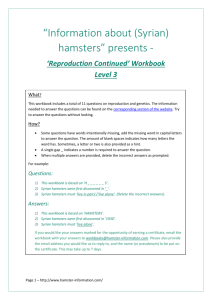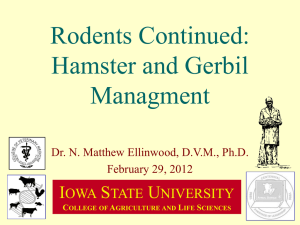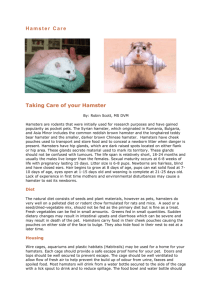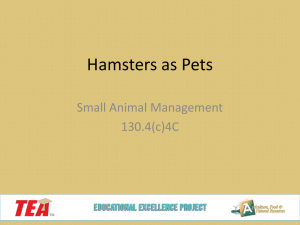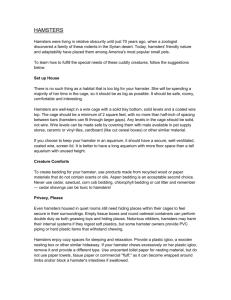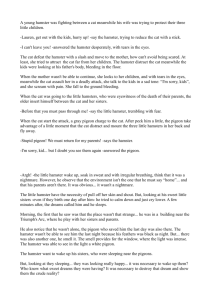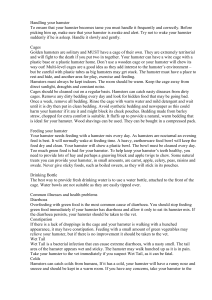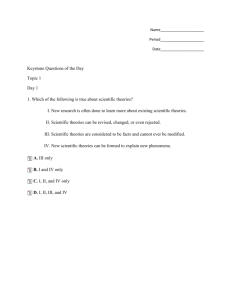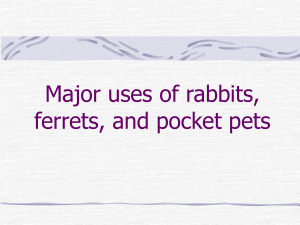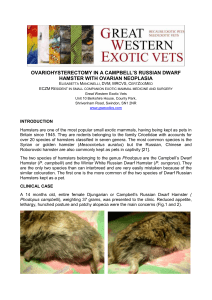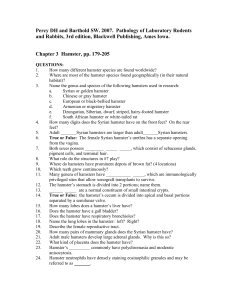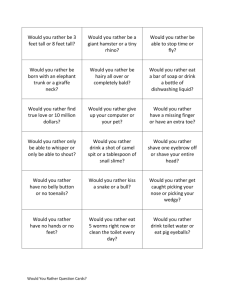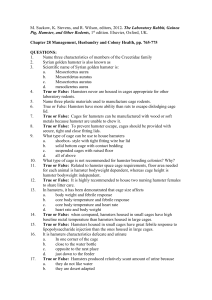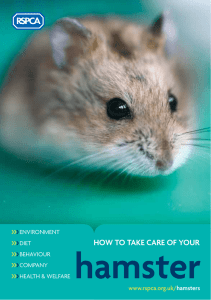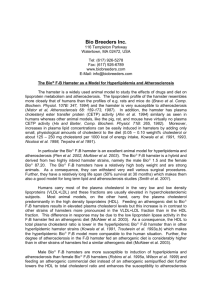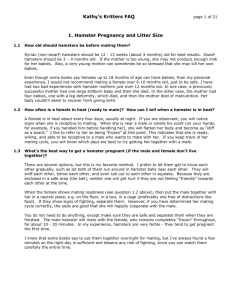File - Information on Syrian hamsters
advertisement
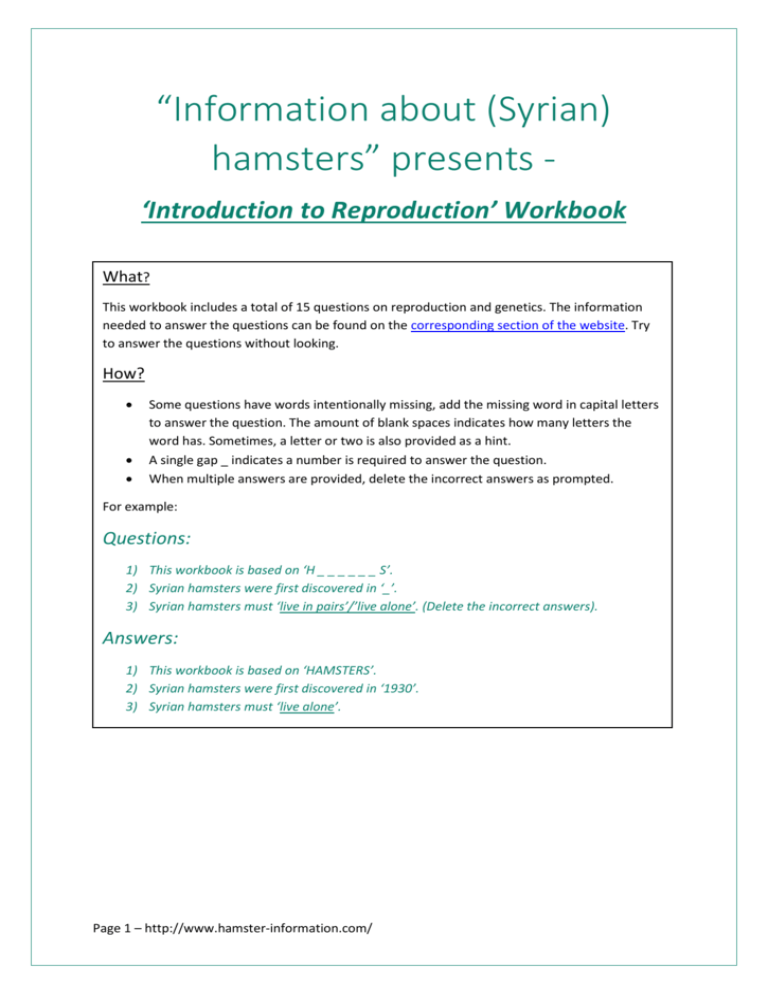
“Information about (Syrian) hamsters” presents ‘Introduction to Reproduction’ Workbook What? This workbook includes a total of 15 questions on reproduction and genetics. The information needed to answer the questions can be found on the corresponding section of the website. Try to answer the questions without looking. How? Some questions have words intentionally missing, add the missing word in capital letters to answer the question. The amount of blank spaces indicates how many letters the word has. Sometimes, a letter or two is also provided as a hint. A single gap _ indicates a number is required to answer the question. When multiple answers are provided, delete the incorrect answers as prompted. For example: Questions: 1) This workbook is based on ‘H _ _ _ _ _ _ S’. 2) Syrian hamsters were first discovered in ‘_’. 3) Syrian hamsters must ‘live in pairs’/’live alone’. (Delete the incorrect answers). Answers: 1) This workbook is based on ‘HAMSTERS’. 2) Syrian hamsters were first discovered in ‘1930’. 3) Syrian hamsters must ‘live alone’. Page 1 – http://www.hamster-information.com/ Questions: 1) Male and female hamsters have different sex cells, they are known as ‘_ _ _ _ _’ and ‘_ _ _’. 2) Another term for a sex cells is a ‘_ _ _ _ _ _’ 3) A chromosome is a microscopic object consisting of very long strands of DNA, there are ‘_’ of them per sex cell in a hamsters. 4) Any particular section or chunk of DNA on a chromosome that codes for a characteristic is known as a ‘_ _ _ _’. 5) The four letter word from question 4 codes for a characteristic, but variations within that gene are known as ‘_ _ _ _ _ _ _’. 6) The location on a chromosome that we can find a ‘G _ _ _’ is known as the ’L _ _ _ _’. 7) If we were referring to a hamsters full genetic code or genetic ‘make up’ we might be referring to its ‘_ _ _ _ _ _ _ _ ‘. 8) The ‘_ _ _ _ _ _ _ _ _’ is the hamsters observable characteristics. 9) Question 5 refers to a term used for variations within genes. A hamster requires two of these (one from either parent) if the characteristic is ‘_ _ _ _ _ _ _ _ _’. But only requires one of them if the characteristic is ‘_ _ _ _ _ _ _ _’ 10) Black fur is represented by ‘a’ - this indicates it is ‘RECESSIVE/DOMINANT. (Delete the incorrect answer). 11) ‘AA’ might be found written on a hamster’s pedigree certificate, this indicates that the hamster has two, one or no ‘black fur’ alleles? (Delete the incorrect answer). 12) A hamster that is AA for black fur is ‘HOMOZYGOUS/’HETEROZYGOUS’ for that trait. Whereas a hamster described as ‘Aa’ is ‘HOMOZYGOUS’ /’HETEROZYGOUS’ for black fur. (Delete the incorrect answers). 13) The colour cream (e) is recessive, and the coat type Satin (Sa) is dominant. Using this knowledge, determine whether a hamster described as ‘ee Sasa’ is ‘CREAM AND SATIN/CREAM BUT NOT SATIN’/’SATIN BUT NOT CREAM’/’NEITHER CREAM NOR SATIN’. (Delete the incorrect answers). 14) The ‘G _ _ _ _ _ _ _ N’ period is another term for the period of time that a hamster is pregnant for, this period is usually a total of ‘_’ days. 15) After intercourse, the two sex cells fertilise into a single ‘_ _ _ _ _ _’ that eventually becomes a hamster of its own. Answers can be found on the following page. Page 2 – http://www.hamster-information.com/ Answers: 1) Male and female hamsters have different sex cells, they are known as ‘SPERM’ and ‘OVA’. 2) Another term for a sex cells is a ‘GAMATE’ 3) A chromosome is a microscopic object consisting of very long strands of DNA, there are ‘22’ of them per sex cell in a hamsters. 4) Any particular section or chunk of DNA on a chromosome that codes for a characteristic is known as a ‘GENE’. 5) The four letter word from question 4 codes for a characteristic, but variations within that gene are known as ‘ALLELES’. 6) The location on a chromosome that we can find a ‘GENE’ is known as the ’LOCUS’. 7) If we were referring to a hamster’s full genetic code or genetic ‘make up’ we might be referring to its ‘GENOTYPE ‘. 8) The ‘PHENOTYPE’ is the hamster’s observable characteristics. 9) Question 5 refers to a term used for variations within genes. A hamster requires two of these (one from either parent) if the characteristic is DOMINANT’. But only requires one of them if the characteristic is RECESSIVE’ 10) Black fur is represented by ‘a’ - this indicates it is ‘recessive’. 11) ‘AA’ might be found written on a hamster’s pedigree certificate, this indicates that the hamster has no ‘black fur’ alleles. 12) A hamster that is AA for black fur is’ homozygous’ for that trait. Whereas a hamster described as ‘Aa’ is ‘heterozygous’ for black fur. 13) The colour cream (e) is recessive, and the coat type Satin (Sa) is dominant. Using this knowledge, determine whether a hamster described as ‘ee Sasa’ is ‘cream and satin’. 14) The ‘GESTATION’ period is another term for the period of time that a hamster is pregnant for, this period is usually a total of ‘16’ days. 15) After intercourse, the two sex cells fertilise into a single ‘ZYGOTE’ that eventually becomes a hamster of its own. Page 3 – http://www.hamster-information.com/

